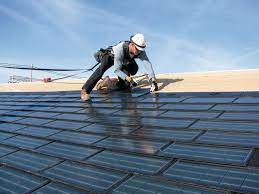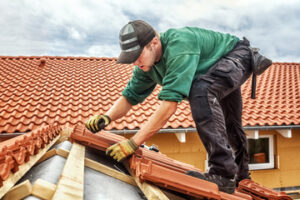Your roof is your home’s first line of defense against the elements. It’s critical to understand when an issue crosses the line from “needs some attention” to “emergency.”

Safeguarding your property until roofing professionals arrive requires swift action and informed decisions. Read on to learn the essential steps for navigating Emergency Roof Repair Murfreesboro TN.
There are several things homeowners can do when they discover roof damage, from assessing the situation to preparing for professional repair. The most important thing is to make sure that everyone’s safety is prioritized. Homeowners should avoid climbing onto damaged structures and instead stay indoors and inspect the situation from the ground or through windows. This will prevent further harm to the property, such as mold or water damage. If possible, tarps can be used to cover damaged areas and keep water out while the roof is repaired. Homeowners should also move any valuable or fragile items away from areas of the roof that could be compromised.
It’s also essential to document the damage for insurance purposes. Keeping detailed records and maintaining open communication with the insurance company can help speed up the claim process. A good local roofing contractor can help guide homeowners through the insurance claims process, including providing detailed reports on the damages and estimate for repairs.
Many issues can cause an emergency roof repair, including missing shingles, damage from fallen debris, and flooding caused by a clogged or blocked gutter system. It’s important to take steps to prevent these problems from occurring in the first place, such as performing regular roof inspections, cleaning gutters and downspouts, and trimming tree branches. A well-maintained roof can also extend the lifespan of the structure and prevent costly replacements in the future.
If a homeowner suspects that their roof is in need of emergency repair, they should contact a licensed and experienced roofing professional right away. Reputable professionals can offer a variety of services, including securing tarps, sealing leaks, and conducting a complete inspection to identify the root cause of the problem. A thorough inspection can lead to a long-term solution, such as replacing old or damaged shingles or reinforcing the roof valleys.
The best time to conduct a roof repair is on a clear, dry day. It’s easier for the roofing team to work and ensures that the materials adhere properly. If it’s raining or snowing, a temporary solution should be put in place until the weather improves.
Protecting Your Property
Your roof safeguards your property from the elements and maintains insulation, but even the sturdiest roofing materials can be susceptible to damage. Whether caused by severe weather, falling debris, or sudden leaks, these emergencies require prompt attention to avoid structural damage, mold growth, and interior water damage. Emergency roof repair can be an expensive endeavor, but taking the right precautions can minimize damages and save you money in the long run.
Start by assessing the extent of the damage and documenting it thoroughly. Take clear photos of any affected areas, including any damage to walls and ceilings inside your home. This will help your roofing contractor understand the scope of the work needed and provide accurate estimates for repair costs. Additionally, a detailed list of damaged areas will help support your insurance claim.
Once you’ve documented the damage, stay safe and move any personal belongings from areas that might be impacted by a flood or further storm damage. If possible, move electronics and furniture to a safe, dry area to prevent further moisture damage. Be sure to note any water stains or discoloration on your ceilings and walls, as this is another sign of a leaky roof.
Next, examine the attic space to look for wet insulation or signs of leaks. Leaks in the attic are often due to shingles that were improperly installed or gaps in the roof structure. Look for shingles that are missing or sagging, and listen for any rattling or whistling sounds. These indicate that the roof is at risk of tearing or collapsing in high winds, which could lead to further damage.
A good roofer can make emergency repairs and restore your home to its original condition, but if you don’t perform routine maintenance and inspections, minor issues can turn into major ones before you know it. Taking the time to perform these simple tasks can protect your investment, keep your family and pets safe, and extend the life of your roofing materials.
Keeping your roof in top shape is essential to protecting the integrity of your home and minimizing costly damage. By implementing regular roof inspections, understanding the warning signs of damage, and having an emergency plan in place, you can ensure that your home’s roof is sturdy and ready for harsh weather conditions.
Contacting Your Insurance Provider
When it comes to emergency repairs, you need to act fast. Not only will it minimize the damage, but it can also save you money in the long run.
The first step is to assess the damage and make sure your safety and that of your family aren’t at risk. It’s also important to document the damage thoroughly with photos or notes. This can be helpful for insurance claims and helping your roofing company understand the scope of the work that needs to be done.
You should also try to mitigate further damage by placing tarps on any problem areas. This will help to prevent water leaks that can lead to mold and rot, as well as further structural damage to your home. It’s also a good idea to move any items away from the affected area, especially if they are valuable or fragile.
It’s always a good idea to schedule regular inspections for your roof. These will allow a professional roofer to examine your roof for early signs of wear and tear that might otherwise go unnoticed. This will also allow them to spot any potential problems like loose shingles or small leaks that can be repaired before they become major issues.
If you notice that your roof has sustained severe damage from a storm, it’s crucial to contact a roofing professional right away. Don’t try to climb onto your roof yourself for any temporary repair work as this could be dangerous and may even void your homeowners insurance coverage.
When you call a roofing professional for an emergency roof repair, they will come out to your home and inspect the damage. They’ll then be able to give you an estimate for the necessary repairs. They’ll also be able to assist you in filing an insurance claim, which can be a complicated process if you’ve never done it before.
Although you can avoid costly repair costs with routine maintenance and insurance, emergency roof repair is an unfortunate fact of life for many homeowners. However, by following these tips, you can be prepared for when the unexpected happens and minimize any unnecessary damage.
Getting Started
While a well-maintained roof can minimize the chances of emergency roofing issues, it can’t eliminate them entirely. However, if your property experiences damage due to a storm, it’s important to know how to handle the situation effectively so that you can minimize damage and keep your property safe until professionals can arrive to repair it.
A thorough visual inspection is the first step to taking care of any roofing issues. This can include looking for any exterior issues like hail dents or loose debris, as well as checking the interior of your property for signs of roof leaks like water stains on the ceiling. Taking photos and making notes is also a good idea, as this documentation will be invaluable when filing an insurance claim or requesting emergency repairs from a roofing professional.
It’s important to remember that safety is paramount when assessing and performing any kind of work on your roof. Even if it’s only a minor issue, don’t try to climb onto your roof unless you are sure it is safe to do so and that you have a ladder with you. Using binoculars from the ground or a high vantage point can also be a safer option than trying to navigate a damaged roof yourself, especially if you notice large areas of damage that may need to be patched or repaired.
One of the best ways to prepare for an emergency roof repair is by having a stash of materials on hand. Having a plastic tarp and some roofing cement on hand will allow you to quickly cover any areas of damaged or compromised roofing and protect your home from rain until a professional can arrive. While a permanent solution is preferable, this is a quick and easy way to mitigate potential damage and reduce your risk of structural damage.
Aside from having a stash of supplies on hand, it’s a good idea to keep up with routine roof maintenance so that you are less likely to need emergency repairs in the future. This can include regular roof inspections, cleaning gutters and downspouts, trimming tree branches, and addressing small problems as soon as you notice them.








